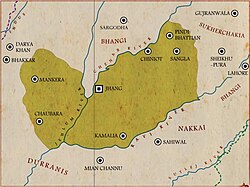| Sial State | |||||||||
|---|---|---|---|---|---|---|---|---|---|
| c. 1727–1816 | |||||||||
 Map of the state of Jhang in Punjab in the mid-18th century Map of the state of Jhang in Punjab in the mid-18th century | |||||||||
| Status | Chieftainship | ||||||||
| Capital | Jhang | ||||||||
| Common languages | |||||||||
| Ethnic groups | Punjabis (with the Sials being the dynastic rulers) | ||||||||
| Religion | Islam (dynastic) | ||||||||
| Chief | |||||||||
| • 1723 – 1747 | Walidad Khan Sial (founder) | ||||||||
| • 1747 – 1787 | Inayatullah Khan Sial | ||||||||
| • 1787 – 1798 | Sultan Kabir Khan Sial | ||||||||
| • 1798 – 1816 | Ahmad Khan Sial (last) | ||||||||
| Area | |||||||||
| • Total | 6,007 sq mi (15,560 km) | ||||||||
| |||||||||
| Today part of | Pakistan | ||||||||
Sial dynasty was a Punjabi Muslim chieftaincy that ruled over the Sial state (c. 1727–1816) in central Punjab during the 18th and 19th centuries. It was centred around the city of Jhang.
History

Jhang has been historically the stronghold of the Punjabi Sial tribe for centuries. The 13th Sial chief, Walidad Khan established a strong regional state in the early-18th century following the decline of the Mughal Empire, which was supported by a large agricultural base along river Chenab. He gradually gained control of the lower Rechna Doab, including the cities of Chiniot, Pindi Bhattian, Jhang and Mankera. Next chief, Inayatullah Khan (r. 1747– 1787) was a successful general who won 22 battles against Bhangi Misl and the Multan chiefs. His son, Sultan Kabir Khan was a mild ruler and his reign was peaceful. In 1798, he abdicated in the favour of his son, Ahmed Khan, who proved to be the last Sial ruler. In 1803, the Sikh ruler of Lahore, Ranjit Singh, sent his agents to Jhang for collecting tribute from Ahmed Khan, who refused. Enraged, Ranjit Singh marched with his army to Jhang. Ahmed Khan collected a force consisting of Sials, Kharrals and Bharwanas, but was defeated owing to the extensive use of cannons by Ranjit Singh, ultimately being forced to pay a tribute of 60,000 rupees per year to Ranjit Singh. Ranjit Singh annexed the Sial capital of Jhang in 1807, on the pretext that Ahmad Khan Sial was making an alliance with Nawab Muzaffar Khan of Multan and had signed a secret treaty with the latter. However, Ahmed Khan seized control of Jhang again in 1808 with the help of Pathans of Multan. Ranjit Singh again invaded Sial-ruled territories in 1810 while going on campaign against the Nawab of Multan, and defeated the outnumbered Sials. The Sial rule came to end in 1816, and Ahmed Khan was awarded a small jagir by Ranjit Singh worth 12,000 rupees in the Amritsar District as compensation.
References
- ^ "Our History". District Jhang. Government of the Punjab.
- ^ Gilmartin, David (2020). Blood and Water: The Indus River Basin in Modern History. University of California Press. p. 93. ISBN 978-0-520-35553-8.
- Zahab, Mariam Abou (2020). Pakistan: A Kaleidoscope of Islam. Oxford University Press. pp. 68–69. ISBN 978-0-19-753459-5.
Jhang is located about 200 kilometres south of Lahore. It had historically a great politico-strategic importance for two reasons: the Sial dynasty was once powerful and Jhang was situated on the main communication line between Lahore and Multan. Parts of the vast district were taken away by the British and later by the Government of Pakistan when they created new districts. Today Jhang consists of three tehsils: Jhang, Chiniot and Shorkot.
- ^ Gupta, Hari Ram (1991). The Sikh Lion of Lahore (Maharaja Ranjit Singh, 1799–1839). History Of The Sikhs. Vol. V. Munshiram Manoharlal. pp. 65–66. ISBN 978-8-121-50515-4.
- ^ "Chap. II. — History". Gazetteer Of The Jhang District. Punjab Government. 1883–84. pp. 23–39.
- ^ Yasmin, Robina (2022). Muslims Under Sikh Rule in the Nineteenth Century. I.B. Tauris. pp. 45–46. ISBN 978-0-7556-4035-5.
- Singh, Rishi (2014). State Formation and the Establishment of Non-Muslim Hegemony: Post-Mughal 19th-century Punjab. SAGE Publications India. ISBN 978-9-3515-0504-4.
When Ranjit Singh realised that Ahmad Khan Sial of Jhang had concluded a secret treaty with Nawab Muzaffar Khan of Multan, he annexed Jhang in 1807 and gave Ahmad Khan a jagir at Mirowal near Amritsar.
- Grewal, J. S. (1998). The Sikhs of the Punjab (Revised ed.). Cambridge University Press. pp. 4, 102–10, 248. ISBN 978-0-521-63764-0. LCCN 99158580.